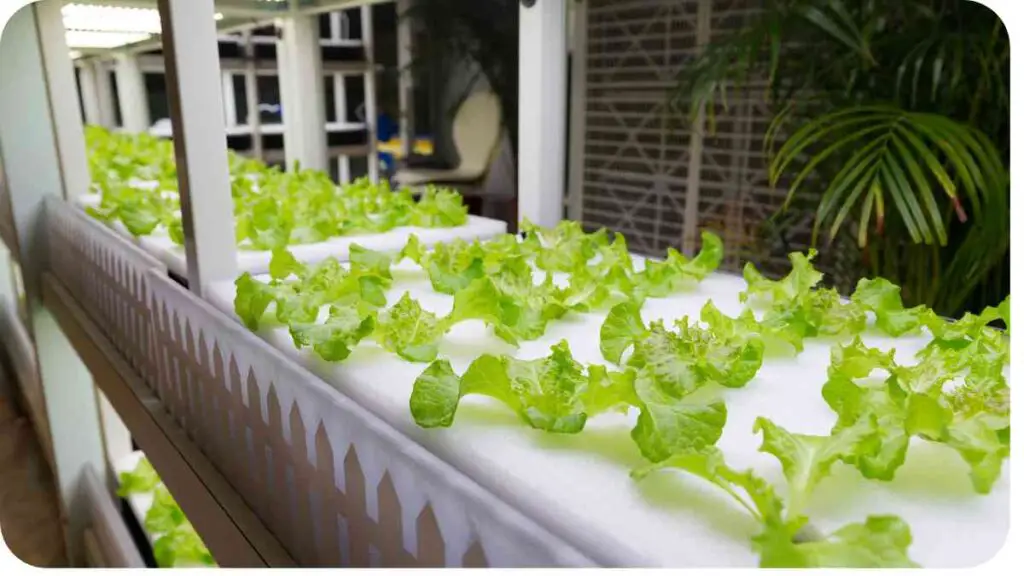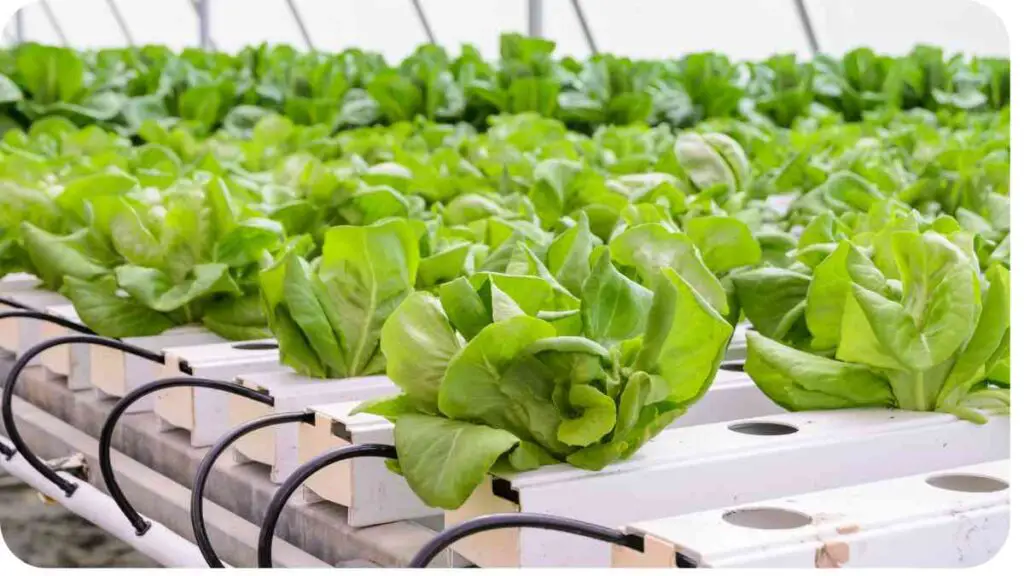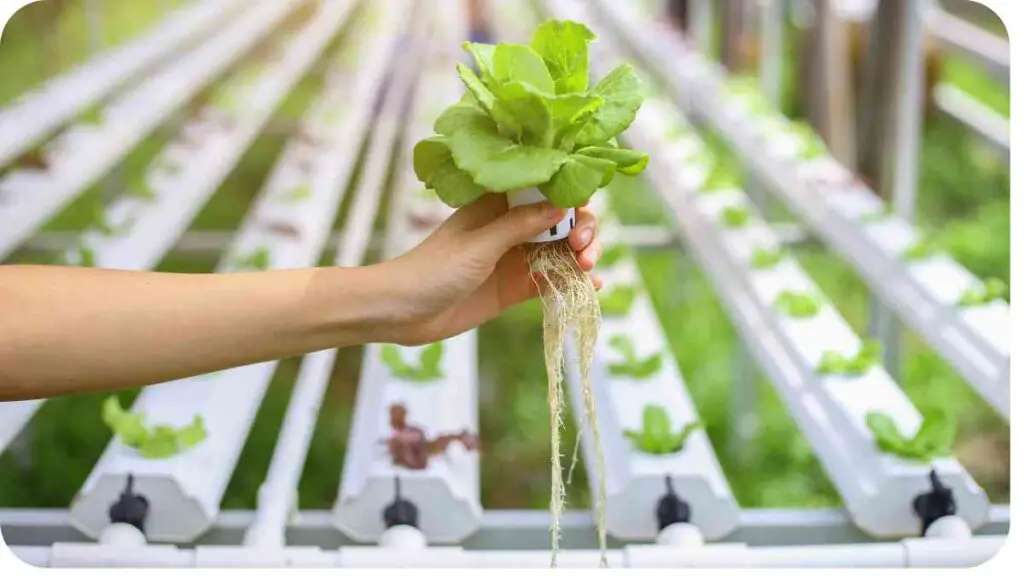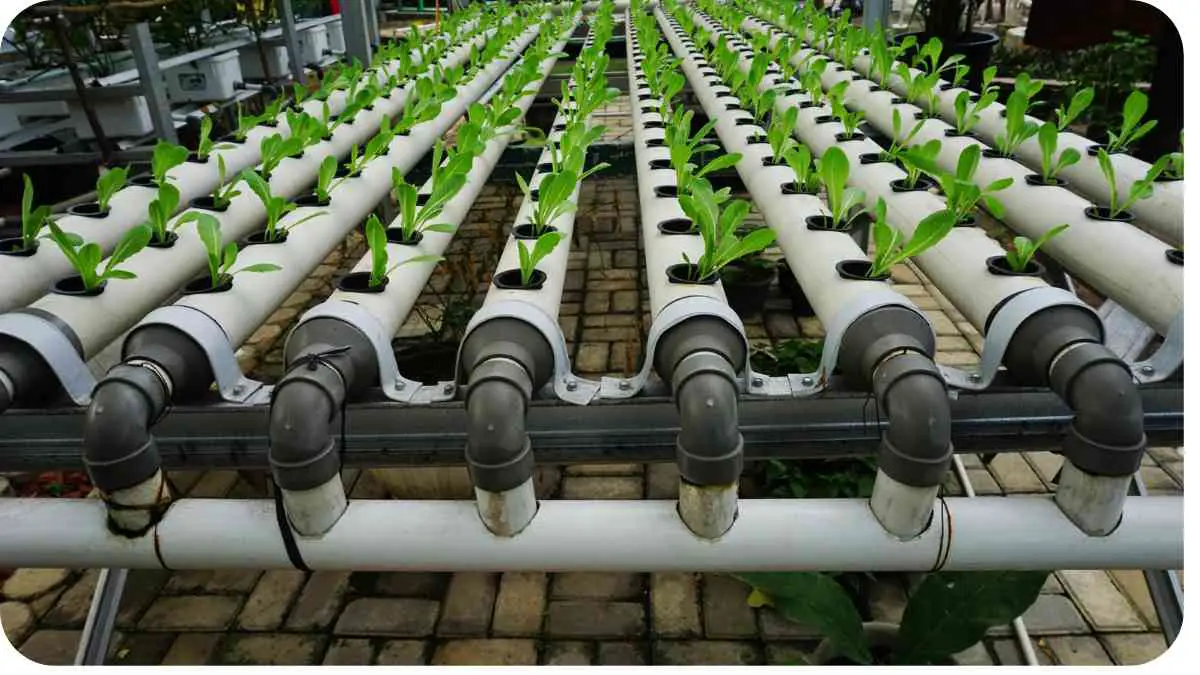Curious about the safety and nutritional value of hydroponic vegetables? In this guide, we delve into the world of hydroponic gardening, exploring its safety measures and nutritional benefits.
Discover how to grow and enjoy fresh, healthy produce without soil. From debunking myths to understanding the pros and cons, we’ve got you covered. Let’s dive in!
And if you’re curious about the profitability of hydroponic stores, don’t miss our post on Are Hydroponic Stores Profitable? for insights into the business side of hydroponic gardening.
| Key Takeaways |
|---|
| Hydroponic vegetables are safe to eat as long as they are grown and handled properly. |
| The nutritional value of hydroponic vegetables can vary depending on growing conditions and the type of crop. |
| Hydroponic vegetables can be just as nutritious as soil-grown vegetables, or even more nutrient-dense in some cases. |
| Growing hydroponic vegetables offers benefits such as reduced water usage and increased crop yields. |
| To ensure the safety of hydroponic vegetables, follow food safety guidelines and use clean water and sterile growing equipment. |
Are Hydroponic Vegetables Safe To Eat?

Yes, hydroponic vegetables are indeed safe to eat when grown and handled properly. Contrary to the misconception presented, hydroponic systems provide a controlled environment for plant growth, ensuring nutrient uptake and minimizing the risk of contamination.
While traditional gardening relies on soil as a medium, hydroponic systems deliver nutrients directly to the plants’ roots through water-based solutions. This method offers numerous benefits, including reduced water usage and increased crop yields.
By following proper hygiene practices and using clean water and sterile equipment, hydroponic vegetables can be a safe and healthy addition to your diet.
When it comes to deciding between hydroponics and soil-based agriculture, there are pros and cons to both. Check out our comprehensive guide on hydroponics vs soil to learn more about the benefits and drawbacks of each method.
Pros and Cons of Hydroponic Growing:
Pros:
- No Weeding, No Mess: Hydroponic systems eliminate the need for manual weeding, reducing labor and mess associated with traditional gardening.
- No Soil or Fertilizers Required: Soilless cultivation in hydroponics allows for efficient nutrient delivery directly to plant roots, eliminating the need for soil and reducing the risk of soil-borne diseases.
- Minimal Watering: Hydroponic systems require less water compared to soil-based gardening, as water is recirculated within the system, reducing water wastage.
Cons:
- High Equipment Cost: The initial investment in hydroponic equipment can be substantial, including pumps, aerators, grow lights, and other components required for system setup and maintenance.
- Indoor Growing Requirement: Hydroponic growing often takes place indoors due to the need for controlled environments, which necessitates the use of artificial lighting and climate control systems, increasing energy consumption.
- Maintenance Challenges: Regular cleaning and maintenance of hydroponic equipment are essential to prevent bacterial buildup and ensure optimal system performance. Neglecting maintenance can lead to crop quality issues and system failures.
While hydroponic growing offers several advantages, it’s important to consider the associated costs and maintenance requirements before investing in a hydroponic system.
| Types of Hydroponic Systems |
|---|
| Deep Water Culture (DWC) |
| Nutrient Film Technique (NFT) |
| Aeroponics |
| Ebb and Flow |
| Drip Irrigation |
| Wick System |
Difference Between Hydroponics and Aquaponics:

Hydroponics:
- Hydroponic growing involves cultivating plants using a nutrient solution instead of soil.
- Plants are typically placed in containers with their roots suspended in a tank containing the nutrient solution.
- Hydroponic gardening is popular for its space-saving nature and the ability to grow produce at home without soil.
- It allows for year-round production of fruits and vegetables, though it may require significant time investment.
Aquaponics:
- Aquaponics integrates aquaculture (fish farming) with hydroponics.
- In an aquaponic system, fish are raised in tanks, and their waste serves as nutrients for plants grown above in the water.
- The plants filter out toxins from the water, creating a symbiotic relationship between fish and plants.
- Aquaponics combines the benefits of both aquaculture and hydroponics, offering a sustainable and efficient method of cultivation.
Are you curious about the environmental impact of hydroponics? Our article on is hydroponics good for the environment? explores the sustainability of this modern farming technique and the potential benefits it could bring to our planet.
How to Water Hydroponic Plants:
In hydroponic systems, plants are watered using nutrient-rich solutions instead of traditional soil. Here’s a breakdown of how watering works in hydroponic gardening:
- Nutrient Solution: Hydroponic plants receive water and essential nutrients directly from nutrient solutions. These solutions contain a balanced blend of nutrients necessary for plant growth, such as nitrogen, phosphorus, and potassium, among others.
- Frequent Watering: Unlike plants grown in soil-based systems, hydroponic plants need to be watered more frequently. Since they don’t have access to natural nutrients and minerals from soil, they rely entirely on the nutrient solution for their growth. Regular watering ensures that plants receive a continuous supply of water and nutrients.
- Controlled Environment: Hydroponic systems allow for precise control over watering cycles and nutrient concentrations. This control ensures optimal growing conditions for plants, leading to healthier growth and higher yields.
- Nutrient Solution Management: It’s essential to monitor and manage the nutrient solution to maintain proper pH levels and nutrient concentrations. pH levels should be regularly checked and adjusted as needed to ensure optimal nutrient uptake by plants.
- Ready-Made Solutions: Nutrient solutions are commercially available and come pre-formulated with the correct balance of nutrients. This eliminates the need for guesswork and ensures that plants receive all the necessary elements for healthy growth.
By providing plants with a continuous supply of water and nutrients through nutrient solutions, hydroponic gardening offers a controlled and efficient method of cultivation, resulting in robust and productive plants.
How Often to Feed Hydroponic Nutrients:

Hydroponic growers typically feed their plants with a nutrient solution on a daily basis. Here’s a breakdown of nutrient feeding in hydroponic systems:
- Daily Feeding: Hydroponic plants require regular feeding with a nutrient solution to support their growth and development. Daily feeding ensures that plants receive a continuous supply of essential minerals and growth-promoting elements.
- Manufacturer’s Instructions: It’s important to follow the manufacturer’s instructions for nutrient application. The recommended dosage and frequency of nutrient feeding may vary depending on the specific hydroponic system and the stage of plant growth.
- During Watering Cycles: Nutrients are typically added to the hydroponic system during each watering cycle. This ensures that plants have access to nutrients whenever they are watered, promoting healthy root development and overall plant growth.
- Quality Control: When purchasing hydroponic nutrients, it’s advisable to choose products from reputable manufacturers. Look for manufacturers who conduct third-party testing for heavy metals, pesticides, and other contaminants to ensure product safety and quality.
Benefits of Using a Hydroponic System:
A hydroponic system offers numerous advantages for plant cultivation. Here’s an overview of its benefits and how it works:
- Efficient Nutrient Delivery: Hydroponic systems deliver nutrient solutions directly to plant roots, ensuring optimal nutrient uptake and promoting healthy growth.
- Weed-Free Environment: Since hydroponic plants are grown without soil, there are no weeds to contend with. This reduces the need for manual weeding and helps maintain a clean growing environment.
- Pest and Disease Control: Hydroponic systems minimize the risk of pests and diseases commonly associated with soil-based gardening. Without soil, there are fewer opportunities for pests and pathogens to thrive, reducing the need for chemical pesticides.
- Space Saving: Hydroponic systems can be designed to maximize space utilization, making them ideal for urban or indoor gardening. Vertical hydroponic setups, for example, allow for efficient use of vertical space.
- Climate Control: Hydroponic systems enable precise control over environmental factors such as temperature, humidity, and light intensity. This allows growers to create optimal growing conditions regardless of external weather conditions.
- Year-Round Cultivation: With indoor hydroponic systems, growers can cultivate plants year-round, regardless of seasonal limitations. This provides a consistent supply of fresh produce regardless of the time of year.
- Customizable Design: Hydroponic systems can be tailored to suit the specific needs of different plants and growing environments. From small-scale home setups to large commercial operations, hydroponic systems offer flexibility in design and scalability.
- Reduced Water Usage: Hydroponic systems use water more efficiently compared to traditional soil-based gardening. Water is recirculated within the system, reducing water wastage and promoting sustainability.
Do Plants Grow Faster In Hydro Or Soil?
Plants grown in hydroponic systems often exhibit faster growth rates compared to those grown in soil. Here’s why:
- Optimized Nutrient Uptake: In hydroponic systems, plants have direct access to a well-balanced nutrient solution, allowing for efficient nutrient uptake. This optimized nutrient availability promotes rapid growth and development.
- Improved Oxygenation: The roots of hydroponically grown plants are exposed to oxygen-rich water, enhancing root development and nutrient absorption. This improved oxygenation boosts plant metabolism and accelerates growth.
- Controlled Environment: Hydroponic systems provide a controlled environment with stable conditions, including temperature, humidity, and light intensity. This controlled environment minimizes stress on plants and optimizes their growth potential.
- Reduced Competition: Without the presence of weeds or competing plants, hydroponically grown plants can allocate more energy towards growth and development, leading to faster growth rates.
- Year-Round Cultivation: With hydroponic systems, growers can cultivate plants year-round, eliminating seasonal limitations and allowing for continuous growth cycles.
While plants grown in soil can also thrive under optimal conditions, hydroponic systems offer several advantages that promote faster and more efficient growth. By providing plants with ideal growing conditions and nutrient availability, hydroponic gardening enables growers to achieve quicker harvests and maximize yields.
Many people wonder if hydroponic vegetables are as nutritious as traditional produce. To learn more about the nutritional value of hydroponic vegetables, check out our article on are hydroponic vegetables nutritious? and discover how these crops stack up against their soil-grown counterparts.
Is it Cheaper to Grow Plants Hydroponically or Using Soil?
The cost comparison between hydroponic and soil-based gardening depends on various factors. Here’s a breakdown:
Hydroponic Gardening:
- Initial Investment: Hydroponic systems typically require an initial investment in equipment such as pumps, reservoirs, and grow lights. While this initial cost can be significant, it can be offset over time by increased yields and reduced water usage.
- Operating Costs: Hydroponic systems may have lower operating costs in the long run due to efficient nutrient delivery and reduced water evaporation. However, ongoing expenses for electricity and nutrient solutions should be considered.
- Space Efficiency: Hydroponic systems can be designed to maximize space utilization, making them suitable for small or indoor gardens. This space efficiency may result in higher yields per square foot compared to traditional soil-based gardening.
Soil-Based Gardening:
- Lower Initial Cost: Soil-based gardening typically has lower initial costs since it doesn’t require specialized equipment. Basic gardening tools and soil amendments may be all that’s needed to start.
- Soil Quality: Ensuring soil quality is crucial for successful soil-based gardening. This may involve additional expenses for soil testing, amendments, and fertilizers to maintain nutrient levels and soil health.
- Environmental Impact: Soil-based gardening may have fewer environmental concerns regarding chemical runoff and energy consumption compared to hydroponic systems.
Can You Grow Plants in Just Water?
Yes and no. While it’s possible to grow plants in just water, they won’t thrive or survive without essential nutrients and a suitable growing medium. Here’s why:
- Nutrient Requirements: Plants require essential nutrients such as nitrogen, phosphorus, and potassium for growth and development. Without these nutrients, plants will not be able to carry out vital processes like photosynthesis and cell growth.
- Growing Medium: Plants also need a growing medium to support their roots and provide stability. While water alone can hydrate plants, it doesn’t offer the structural support necessary for root growth. A growing medium like soil, sand, or inert materials in hydroponic systems provides physical support and helps anchor roots in place.
- Hydroponic Solutions: In hydroponic gardening, plants receive essential nutrients from water solutions rather than soil. These solutions are carefully formulated to provide plants with the necessary nutrients at different growth stages. However, even in hydroponic systems, a suitable growing medium is still required to support root growth and stability.
If you’re interested in growing hydroponically without soil, you’ll need a suitable growing medium such as perlite, vermiculite, or Rockwool cubes. These materials provide structural support for roots while allowing for efficient nutrient uptake from the water solution.
Additionally, a pump system is necessary in hydroponic setups to circulate the nutrient solution and ensure even distribution to plant roots. Without proper circulation, plants may experience nutrient deficiencies or uneven growth.
Can You Grow Plants On Sand?
While sand is sometimes touted as a suitable medium for growing hydroponic plants, it may not be the best choice. Here’s why:
- Limited Nutrients: Sand lacks essential nutrients necessary for plant growth. Unlike soil, which contains organic matter and a variety of nutrients, sand is relatively inert and provides little to no nutritional value for plants.
- Poor Water Retention: Sand has low water retention capabilities, meaning it drains quickly and may not adequately hydrate plant roots. This can lead to drought stress and hinder plant growth, especially in environments with limited water availability.
- Aeration Challenges: Although sand provides good aeration due to its coarse texture, excessive drainage can also lead to issues with waterlogged roots. Without sufficient oxygenation, plant roots may suffocate and become susceptible to root rot and fungal diseases.
- Limited Support: Sand may not provide adequate support for plant roots, especially in larger plants or those with extensive root systems. This lack of support can lead to instability and poor nutrient uptake, negatively impacting plant health and growth.
Are you concerned about the organic status of hydroponic vegetables? Our article on are hydroponic vegetables organic? takes a closer look at the certification process and the debate surrounding hydroponic crops and their place in organic farming.
Are all indoor gardens hydroponic?
No, not all indoor gardens are hydroponic. While hydroponic gardening is a method of growing plants without soil, there are various other techniques used in indoor gardening as well. Here’s an overview:
- Hydroponic Gardening: Hydroponic systems use water as a growing medium and deliver nutrients directly to plant roots. These systems can range from simple setups like deep water culture to more complex systems like nutrient film technique (NFT) or aeroponics.
- Soil-Based Indoor Gardening: Many indoor gardens utilize traditional soil-based growing methods. Indoor pots or containers filled with potting soil are commonly used to grow a variety of plants, including herbs, vegetables, and ornamentals.
- Container Gardening: Container gardening involves growing plants in containers filled with soil or soilless mixtures. These containers can be placed indoors near windows or under grow lights to provide adequate light for plant growth.
- Vertical Gardening: Vertical gardening utilizes vertical space to grow plants, often in stacked tiers or wall-mounted planters. While some vertical gardening systems may incorporate hydroponic or aeroponic methods, others use soil-based growing mediums.
- Aeroponic Systems: Aeroponic systems suspend plant roots in the air and mist them with nutrient-rich water solutions. While similar to hydroponic systems, aeroponics use air as the primary growing medium instead of water.
- Terrariums and Indoor Landscaping: Some indoor gardens focus on creating miniature ecosystems in enclosed terrariums or showcasing indoor landscapes with a variety of plants. These setups often incorporate soil-based growing mediums and decorative elements.
Are Hydroponic Vegetables Safe to Eat?
Hydroponic vegetables are grown without soil, using water as the medium for plant growth. While hydroponic gardening offers benefits such as controlled temperature and nutrient levels, concerns about food safety persist.
One primary risk associated with hydroponic produce is the potential presence of soil-borne pathogens. Unlike soil-grown crops, hydroponic vegetables may not undergo the same natural cleansing process. Therefore, there’s a possibility that pathogens remain present despite washing or processing methods.
Consumers should be cautious about the source and handling of hydroponic vegetables to mitigate these risks. It’s essential to choose reputable suppliers who follow rigorous hygiene practices during cultivation, harvesting, and packaging.
Despite these concerns, many people find hydroponic vegetables to be a convenient and sustainable option for home gardening. With proper precautions and careful attention to food safety practices, hydroponically grown produce can be enjoyed safely as part of a balanced diet.
Conclusion
In summary, hydroponic vegetables are indeed safe to eat when grown and handled properly. By utilizing a high-quality hydroponic system and adhering to good gardening practices, consumers can enjoy fresh produce without concern.
One significant consideration in hydroponic gardening is the potential for anaerobic bacteria growth in reservoirs or stagnant tanks. However, this risk can be mitigated through proper water circulation and adequate air exchange.
Overall, with attention to hygiene, system maintenance, and water quality, hydroponic vegetables offer a safe and convenient option for home cultivation, providing fresh and nutritious produce year-round.
If you’re curious about the nutritional value of hydroponic vegetables, our article on are hydroponic vegetables as nutritious as other vegetables? provides a comparison between hydroponic and traditional produce, giving you a better understanding of how these crops measure up in terms of health benefits.
Further Reading
If you’re interested in learning more about hydroponic vegetables and their safety and nutritional value, check out the following resources:
Are Hydroponic Vegetables as Nutritious as Those Grown in Soil?: This article from Agritecture explores the nutrient content of hydroponic vegetables compared to soil-grown produce, and how different factors can affect their nutritional value.
Are Hydroponics Vegetables Safe?: Your Indoor Herbs provides an overview of the safety concerns associated with hydroponic vegetables and how to ensure that your crops are grown and consumed safely.
Are Hydroponic Vegetables Healthy?: Livestrong delves into the health benefits of hydroponic vegetables and how they can be a nutritious addition to your diet.
FAQs
What are hydroponic vegetables?
Hydroponic vegetables are crops that are grown without soil, using nutrient-rich water as their growing medium.
Are hydroponic vegetables safe to eat?
Yes, hydroponic vegetables are safe to eat as long as they are grown and handled properly. It is important to use clean water and to follow food safety guidelines when growing and consuming hydroponic vegetables.
Are hydroponic vegetables as nutritious as soil-grown vegetables?
Hydroponic vegetables can be just as nutritious as soil-grown vegetables, and in some cases, they may even be more nutrient-dense. However, the nutritional content of hydroponic vegetables can vary depending on the growing conditions and the type of crop.
What are the benefits of growing hydroponic vegetables?
Growing hydroponic vegetables can offer a number of benefits, including reduced water usage, increased crop yields, and the ability to grow crops in urban or indoor environments.
How do I ensure that my hydroponic vegetables are safe to eat?
To ensure that your hydroponic vegetables are safe to eat, it is important to follow food safety guidelines and to use clean water and sterile growing equipment. It is also a good idea to regularly test your water source for contaminants.

For 15 years, Hellen James has worked in the gardening industry as an expert and landscape designer. During her career, she has worked for a variety of businesses that specialize in landscaping and gardening from small firms to large corporations.

